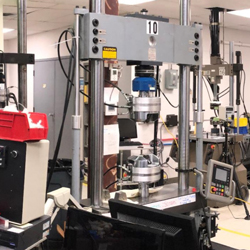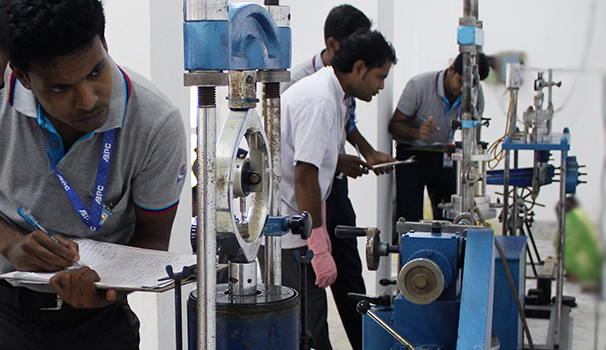Material Testing Lab Insights: Discover the Scientific Research Behind Project Toughness
Material Testing Lab Insights: Discover the Scientific Research Behind Project Toughness
Blog Article
Digging Into the Globe of Product Screening and Evaluation
Material testing and evaluation plays a critical duty in numerous markets, from manufacturing to construction. It includes a methodical examination of different materials to determine their residential properties, performance, and dependability. By using a variety of strategies, such as devastating and non-destructive examinations, experts have the ability to uncover valuable insights regarding the behavior and features of products. The devices utilized in product screening have developed considerably, enabling scientists and designers to obtain a deeper understanding of the materials they work with. In this discussion, we will certainly discover the importance of product testing, dig into typical methods and tools, discuss applications throughout industries, and highlight arising fads that are shaping the future of this area.
Value of Product Screening
Product screening is an essential facet of the design and production industries, ensuring the high quality, integrity, and security of materials made use of in numerous applications. The relevance of product testing can not be overstated, as it plays a crucial function in assuring the performance and durability of items and frameworks.
Among the main factors for carrying out product testing is to analyze the mechanical residential properties of products. This consists of determining their strength, firmness, durability, and flexibility. By subjecting materials to various mechanical examinations, designers can precisely evaluate their suitability for specific applications and ensure they satisfy the called for criteria and requirements.
An additional critical facet of material testing is the recognition of prospective flaws or defects. By utilizing non-destructive screening techniques such as ultrasonic testing or visual evaluation, suppliers can identify any flaws that could endanger the architectural integrity or capability of the materials. This aids in protecting against expensive failures, crashes, and potential obligations.
Moreover, product screening likewise enables the assessment of material habits under various environmental conditions. Elements such as temperature level, moisture, and destructive environments can significantly affect the efficiency and life-span of materials. By subjecting them to environmental testing, engineers can assess their resistance to such conditions and make informed choices concerning their suitability for details applications.
Usual Strategies in Material Analysis
Various techniques are typically utilized in the evaluation of products to identify their qualities and buildings. These strategies play an important function in recognizing the habits and performance of materials in different applications.
One more commonly utilized strategy is spectroscopy, which involves the communication of products with electromagnetic radiation. Infrared spectroscopy can determine the functional groups present in a material, while ultraviolet-visible spectroscopy can establish its optical homes. X-ray diffraction is another effective strategy that enables researchers to evaluate the crystal structure of materials and identify their stages.
Thermal analysis is also commonly employed to study the thermal behavior of materials. Differential scanning calorimetry, as an example, can figure out the melting point and warm capacity of a product, while thermogravimetric analysis can gauge its fat burning as a feature of temperature level.
In addition, mechanical screening is essential to comprehend the mechanical buildings of materials. Methods such as tensile testing, hardness testing, and influence testing provide important details regarding a material's stamina, sturdiness, and rigidity.
Devices Utilized in Product Screening
A variety of specialized instruments and equipment is used in material screening to properly analyze the buildings and actions of various materials. These devices are vital for performing experiments and acquiring trusted data in various markets, consisting of aerospace, auto, building, and production.
One of the most common tools utilized in product screening is the universal testing maker (UTM) This device applies controlled pressures to a product sampling and gauges its feedback, such as tensile strength, return strength, and prolongation. Another necessary tool is the firmness tester, which figures out a product's resistance to impression or penetration. Various types of solidity tests, such as Rockwell, Brinell, and Vickers, are performed relying on the product and its homes.

In addition, thermal evaluation tools, including differential scanning calorimeters (DSC) and thermogravimetric analyzers (TGA), are used to check out the thermal homes and actions of products, such as melting points, glass transitions, and disintegration temperature levels.
Applications of Material Screening and Analysis
To fully use the useful information acquired via the use of specialized tools and tools in material screening, it is essential to explore the variety of applications where this analysis can be applied. Material screening you could try this out and analysis play an important duty in different sectors, consisting of aerospace, auto, building and construction, and manufacturing.
In the aerospace market, material screening and analysis are utilized to ensure the safety and security and reliability of aircraft elements. material testing lab. By subjecting materials to extreme conditions, such as heats and stress, engineers can assess their performance and make educated decisions regarding their suitability for use in airplane
In the vehicle sector, material screening and evaluation are utilized to improve the longevity and efficiency of lorries. By examining the buildings of various materials, producers can develop more powerful and lighter parts, resulting in enhanced fuel effectiveness and overall lorry performance.
In the construction sector, product screening and analysis are utilized to make sure the structural honesty of structures and infrastructure - material testing lab. By assessing the strength and toughness of building products, engineers can create frameworks that can withstand various lots and environmental conditions, making certain the safety of passengers
In the production market, product testing and evaluation are vital for quality control functions. By analyzing the residential properties of resources and ended up items, suppliers can recognize any type of weak points or problems, enabling them to make necessary enhancements and deliver top notch products to consumers.
Future Trends in Product Screening and Analysis
Emerging modern technologies are improving the field of material testing and evaluation, transforming the way sectors enhance the efficiency and examine of products. As modern technology proceeds to advancement, brand-new fads are emerging that are expected to better enhance the capacities of material screening and analysis.
One of the essential future patterns in material testing and analysis is the usage of artificial intelligence (AI) and device knowing (ML) formulas. These technologies can assist in automating the evaluation process, enabling faster and extra precise results. AI and ML can likewise aid in recognizing patterns and fads in big datasets, enabling researchers to make more educated choices.
Another trend is the advancement of sophisticated non-destructive screening (NDT) methods. NDT approaches, such as ultrasonic testing and thermal imaging, are ending up being more innovative, enabling the discovery of problems and issues in products without the demand for devastating screening. This not only saves time and sources but additionally ensures the stability of the examined materials.
Furthermore, there is a growing interest in nanotechnology and its influence on product testing and evaluation. Nanomaterials show distinct homes that vary from their bulk equivalents, and specialized techniques are being developed to assess and characterize these materials at the nanoscale.
Conclusion
Finally, material screening and analysis is an essential element of numerous sectors and study areas. It enables the examination and understanding of product residential properties, guaranteeing quality and safety and security in different applications. Common techniques and devices are made use of to perform these examinations, offering beneficial insights and data. As technology remains to advancement, future fads in material testing and evaluation are expected to even more improve accuracy, try this performance, and advancement in this area.

Report this page